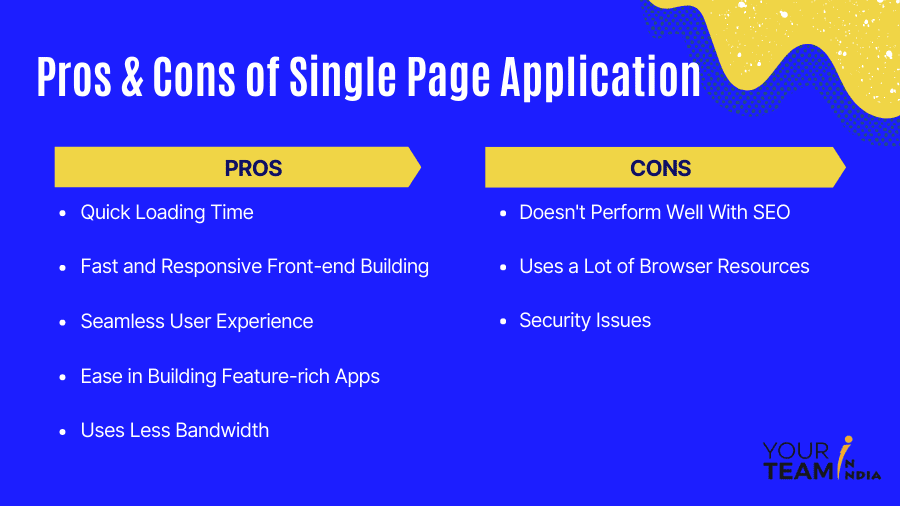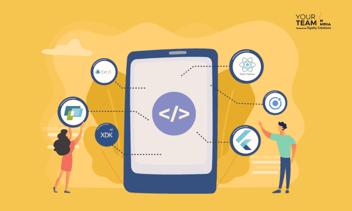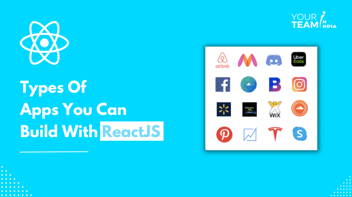Summary: Today's consumers can interact more with your brand if you create unique and engaging experiences. SPA configurations ensure the user enjoys a real environment of the app while eliminating the waiting time for the page reloads. SPAs enable you to stay on the same page while scrolling the app, powered by JavaScript programming language.
A well-performed one-page website can express the products or services of all sizes of businesses. Even if the site structure appears limited, its simple layout could be sufficient to entice audiences to focus on a specific aspect of a business and drive conversions.
This is the major reason why many organizations have started to build parts of their web applications using an emerging web design referred to as a Single Page Application.
Google and Facebook, the two giants whose apps drive your daily dose of the internet and social media activity, have also been built using SPAs.
So, what exactly is a single-page application? Where are they used, and what technologies are used to build them? This blog post answers all these questions.
Single Page Application - An Overview
A single-page application is a web application or website that doesn't need to reload the page during its use and works within a browser. When you interact with a SPA, only a few elements are updated by scrolling or clicking on an image.
For example, when you scroll via Netflix, the dashboard stays in place, and only new titles are refreshed. Think of the apps you use daily: Facebook, Google Maps, Gmail, Twitter, Google Drive, or even GitHub. All these are single-page application examples.
What Is Single Page Application Architecture?
The demand for single-page application development is continuously rising. And why not? Using a website or a web application that dynamically rewrites the current page instead of loading entire new pages from the server delivers an excellent user experience.
In addition, it mitigates the chances of interruptions in a user's journey, which is critical for web apps — especially in digital commerce. Reducing the lag time between existing pages makes the site behave similarly to a desktop application, delivering a more fluid and comfortable experience.
What Technologies Are Used in Single Page Applications?
Various techniques allow the browser to maintain a single page even when the application needs server communication. Let's explore them.
1. Document Hashes
HTML authors can leverage element IDs to hide or show the HTML document's different sections. Then, with CSS, authors can utilize the `#target` selector only to show the page section that the browser navigated to.
2. JavaScript Frameworks
Web browser JavaScript frameworks and libraries have adopted single page application (SPA) principles, such as Knockout.js,Ember.js, ExtJS, AngularJS, Meteor.js, React, Vue.js, and Svelte, Except for ExtJS. Let’s have a quick overview of single-page application frameworks.
- AngularJS is an entirely client-side framework. AngularJS's template relies on bidirectional UI data binding. In simple terms, data-binding can be defined as an automatic process of updating the view whenever the model changes and upgrading the model every time when the view changes.
- Ember.js is a client-side web application framework built on the model–view–controller (MVC) software architectural pattern. It lets developers build scalable single-page applications by incorporating best practices and general idioms into a framework that offers a rich object model, automatically updating templates powered by Handlebars.js, declarative two-way data binding, and a router for managing application state.
- ExtJS is another client-side framework that enables developers to build MVC applications. It has its event system, window and layout management, and several UI components (grids, form elements, dialog windows, etc.). The application developed using ExtJS can either live on its own (with the state in the browser) or with the server ( REST API is an example that is utilized to serve its internal stores).
- Meteor.js is a full-stack (client-server) JavaScript framework created only for SPAs. It features easier data binding than ReactJS, Angular, or Ember. It employs the Distributed Data Protocol and a publish-subscribe pattern to automatically reproduce customer data changes in real-time, eventually mitigating the developer's ability to write any synchronization code. Full stack reactivity guarantees that every layer, from the database to the templates, upgrades itself automatically when required. In addition, ecosystem packages such as Server Side Rendering address the challenges of Search Engine Optimization (SEO).
- React is a JavaScript library used for building user interfaces. It is handled by Instagram, Facebook, and an individual developers' community. React employs a new language, a combination of HTML (a subset of HTML) and JS. Multiple enterprises use React with Redux (JavaScript library), which provides state management capabilities (with several other libraries) and allows developers to create complex applications.
- Vue.js is a JavaScript framework used for building user interfaces. Vue developers also deliver Vuex for state management.
Also read: 9 effective practices to choose the best AngularJS developers
3. Ajax
Ajax has been considered one of the most prominent since 2006. It allows the utilization of asynchronous requests to a server for JSON or XML data.
In distinction to the declarative approach of several SPA frameworks, with Ajax, the website employs JavaScript or a JavaScript library, including jQuery, to exploit the DOM and perform HTML elements edits.
Ajax has further been popularized by libraries like jQuery, which provides a simpler syntax and normalizes Ajax behavior across different browsers, which historically had varying behavior.
4. WebSockets
WebSockets is a bidirectional real-time client-server communication technology that is an element of the HTML5 specification. For real-time communication, their use is outstanding to Ajax in terms of simplicity and performance.
5. Server-sent events
Server-sent events (SSEs) are a technology whereby servers can create data communication with browser clients. Once an initial connection has been established, an event stream stays open until closed by the client. SSEs are transmitted over traditional HTTP and have multiple features that WebSockets lack by design, such as event IDs, automatic reconnection, and the capacity to send arbitrary events.
6. Browser plugins
Although this method is obsolete, asynchronous calls to the server may also be performed utilizing browser plugin technologies such as Flash, Silverlight, or Java applets.
Data transport (Ajax, XML, and JSON)
Requests to the server commonly result in raw data (e.g., JSON or XML) or new HTML being returned. If the server returns Javascript, HTML on the client updates some part of the area of the DOM (Document Object Model).
On the return of Raw Data, a client-side JavaScript XML / (XSL) process (and in the case of JSON, a template) is usually used to decode the raw data into HTML, which is later utilized to update a partial area of the DOM.
7. Server Architecture
- Thin server architecture
A SPA transfer logic to the client from the server, with the function of the web server developing into a pure data API or web service. This architectural shift has, in some processes, been coined "Thin Server Architecture" to underline that complexity has been transferred from the server to the client, with the view that this eventually reduces the overall system complexity.
- Thick stateful server architecture
The server keeps the critical state in memory of the client state of the page. In this way, when any request strikes the server (usually user actions), the server transmits the appropriate Javascript and/or HTML with substantial changes to bring the client to the latest desired state (usually adding/updating/deleting a part of the client DOM).
At the same time, the state of a server is upgraded. Most of the logic is performed on the server, and HTML is usually also generated on the server. In some ways, the server simulates a web browser, accepting events and executing delta changes in the server state which are automatically propagated to the client.
This approach requires more server memory and server processing, but the benefit is a simplified development model because
- a) the application is usually completely coded in the server, and
- b) data and UI state in the server are transmitted in the same memory space with no requirement for custom client/server communication bridges.
- Thick stateless server architecture
This is a version of the stateful server approach. The client page transmits data describing its current state to the server through Ajax requests.
Using this data, the server is capable of reconstructing the client state of the part of the page which must be modified and can develop the critical data or code (for example, JSON or JavaScript), which is returned to the client to obtain it to a new state, usually revising the page DOM tree according to the client activity that encouraged the request.
This approach needs more data to be transmitted to the server and may need more computational resources per demand to partially or fully rebuild the client page state in the server.
At the same time, this technique is easy to scale as there is no per-client page data kept on the server. Therefore, Ajax requests can be sent to different server nodes without the requirement for session data sharing or server affinity.
Single Page Applications - Pros vs. Cons
Like most other technologies, SPAs (single-page applications) have advantages and disadvantages. Knowing each will bring you closer to deciding whether the SPA framework fits your app idea.

Single Page Applications Pros
1. Quick Loading Time
A page taking over 200 milliseconds to load can significantly ruin your online business and, eventually, cost you a lot of money. For example, Amazon says that 1 second of additional delay in page load costs them 1% of sales (considering Amazon's amount of sales is $1.6 billion per year.).
With the SPA approach, your full page loads quicker than traditional web applications, as it only has to load a page at the first request. On the other hand, traditional web apps have to load pages at every request, taking more time.
2. Fast and Responsive Front-end Building
Along with a quicker performance time, single-page applications (SPAs) enable developers to build the front end of sites seamlessly and faster. This is with the help of the decoupled architecture, which is incorporated in SPAs or the separation of back-end services and front-end displays.
Many business-critical functionalities remain intact in the back end. From customers logging in, registering, and purchasing to tracking orders may change its "look" or presentation in regular intervals. Still, the logic and data orchestration behind it is quite steady — and nobody wants to risk messing that up.
Similarly, your raw content and data might remain constant, but how you prefer to display it may differ. By separating that back-end logic and data from how it's displayed, you transform it into a "service," Developers can create several different front-end solutions to show and use that service.
With a separate setup, engineers can build, deploy, and experiment with the front end independently of the significant back-end technology. They create to satisfy the user experience in terms of look and feel and then drag in the content, data, and functionality through those services.
This is accomplished by employing APIs, a pre-defined set of rules between applications on how they will structure, exchange, and reassemble data.
3. Seamless User Experience
SPA frameworks create engaging, dynamic, and even animated user experiences. Plus, many people prefer developing in a specific programming language (several SPA frameworks employ JavaScript), and thanks to APIs, the SPAs you create in one language can perform seamlessly with back-end services built in different languages.
Users do not have to watch a new page load, as only the content changes, not the page, making the experience enjoyable.
4. Ease in Building Feature-rich Apps
Single-page applications (SPAs) make adding advanced features to a web application simple and seamless. For example, building a content-editing web app with real-time analysis employing SPA development is easier. Doing this with a traditional web app needs a total page to reload to execute the content analysis.
5. Uses Less Bandwidth
It is no wonder that SPAs use less bandwidth as they only load web pages once. Besides that, they can also perform great in areas with a slow internet connection. Hence, it is suitable for everyone to use, regardless of internet speed.
Single Page Applications Cons
1. Doesn't Perform Well With SEO
The number of pages a website has is one of the metrics that search engines use. However, since SPAs just load a single page, it is a drawback when ranking on search engines.
2. Uses a Lot of Browser Resources
SPAs need multiple resources from the web browser since the browser does the majority of the tasks for the SPAs. Developing SPAs often require users to use the latest browsers with support for some current features.
3. Security Issues
Single page applications (SPAs) are more inclined to cross-site scripting attacks than multi-page apps (MPAs). Using XSS, it becomes effortless for hackers to make client-side scripts into a web app. Also, SPAs are more potential to expose sensitive data to all users.
Conclusion
Single page applications (SPA) offer numerous benefits. While there are the latest trends in the web applications arena with advances in SPAs such as Progressive Web Apps (PWAs), SPAs are a step in the correct direction towards web application development for the future.
Those businesses that want to build a product to achieve improved visibility, more significant user engagement, and higher productivity for completing tasks or interactively exploring data should explore the fullest potential and the best frameworks for SPAs.
To discover the potential of single page applications (SPAs) for your specific business, connect with our dedicated team of experts for consultation and get and quote on your requirements.








